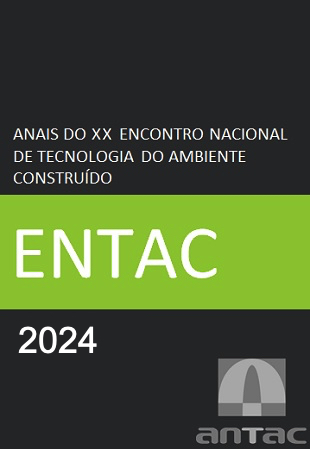BIM and Augmented Reality
Technological Innovations for a Safe Work Environment
DOI:
https://doi.org/10.46421/entac.v20i1.5751Keywords:
BIM, Augmented Reality, Work Safety, Technology, InnovationAbstract
Since its inception, the work environment in the construction industry has been perceived as hazardous due to operations at heights, handling of heavy machinery, and unhealthy environments. Nevertheless, technological advancements bring benefits to the sector, including improvements in worker safety. This article aims to conduct a literature analysis that contributes to the understanding of the integration of Building Information Modeling (BIM) and Augmented Reality (AR) tools in advancing occupational safety. Using the Consolidated Meta-Analytic Focus Theory (TEMAC), 16 articles were filtered based on temporal scope, thematic delineation, title analysis, and abstract reading. A systematic literature mapping reveals the potential of BIM and AR for safety enhancement. Subsequently, recent research emphasizes the pursuit of new technologies to enhance health and safety, such as BIM and AR. The AR environment seeks to integrate BIM tools and prioritize safety. These tools provide interactive training and contribute to the reduction of workplace accidents. This study contributes to effective safety management in construction, enabling professionals in the sector to improve safety performance. The study also highlights research gaps in integrating BIM and AR technologies to improve health and safety at work, emphasizing challenges such as cost, technical complexity, and lack of studies on internal and external factors. Despite the challenges, the integration of these technologies can significantly enhance health and safety in the workplace.
References
FILGUEIRAS, Vitor Araújo et al. Saúde e segurança do trabalho no Brasil. Saúde e Segurança do Trabalho no Brasil. Brasília, p.
-78, 2017.
ANAMT. Construção civil está entre os setores com maior risco de acidentes de trabalho. Disponível em:
www.anamt.org.br/portal/2019/04/30/construcao-civil-esta-entre-os-setores-com-maior-risco-de-acidentes-de-trabalho/>. Acesso
em: 01 ago. 2024.
AFZAL, M.; SHAFIQ, M. T. Evaluating 4D-BIM and VR for Effective Safety Communication and Training: A Case Study of Multilingual
Construction Job-Site Crew. Buildings, v. 11, n. 8, p. 319, 26 jul. 2021.
AFZAL, M.; SHAFIQ, M. T.; JASSMI, H. A. Improving construction safety with virtual-design construction technologies – a review.
Journal of Information Technology in Construction, v. 26, p. 319–340, 20 jul. 2021.
GETULI, V.; CAPONE, P.; BRUTTINI, A. Planning, management and administration of HS contents with BIM and VR in construction:
an implementation protocol. Engineering, Construction and Architectural Management, v. 28, n. 2, p. 603–623, 24 abr. 2020.
DONG, S.; LI, H.; YIN, Q. Building information modeling in combination with real time location systems and sensors for safety
performance enhancement. Safety Science, v. 102, p. 226–237, fev. 2018.
MORA-SERRANO, J.; MUÑOZ-LA RIVERA, F.; VALERO, I. Factors for the Automation of the Creation of Virtual Reality Experiences to
Raise Awareness of Occupational Hazards on Construction Sites. Electronics, v. 10, n. 11, p. 1355, 6 jun. 2021.
GETULI, V. et al. A smart objects library for BIM-based construction site and emergency management to support mobile VR safety
training experiences. Construction Innovation, v. 22, n. 3, p. 504–530, 8 jun. 2022a.
SCHIAVI, B. et al. BIM data flow architecture with AR/VR technologies: Use cases in architecture, engineering and construction.
Automation in Construction, v. 134, p. 104054, fev. 2022.
AHN, S. et al. Improving Effectiveness of Safety Training at Construction Worksite Using 3D BIM Simulation. Advances in Civil
Engineering, v. 2020, p. 1–12, 29 fev. 2020.
DOBRUCALI, E. et al. Investigating the impact of emerging technologies on construction safety performance. Engineering,
Construction and Architectural Management, v. 31, n. 3, p. 1322–1347, 1 mar. 2024.
FARGHALY, K. et al. Digital information technologies for prevention through design (PtD): a literature review and directions for
future research. Construction Innovation, v. 22, n. 4, p. 1036–1058, 28 nov. 2022.
GETULI, V. et al. BIM-based immersive Virtual Reality for construction workspace planning: A safety-oriented approach.
Automation in Construction, v. 114, p. 103160, jun. 2020.
HIRE, S.; SANDBHOR, S.; RUIKAR, K. A Conceptual Framework for BIM-Based Site Safety Practice. Buildings, v. 14, n. 1, p. 272,
jan. 2024.
MANZOOR, B. et al. A Research Framework of Mitigating Construction Accidents in High-Rise Building Projects via Integrating
Building Information Modeling with Emerging Digital Technologies. Applied Sciences, v. 11, n. 18, p. 8359, 9 set. 2021.
RAMOS-HURTADO, J. et al. Proposal for the Deployment of an Augmented Reality Tool for Construction Safety Inspection.
Buildings, v. 12, n. 4, p. 500, abr. 2022.
Scopus - Document details - Virtual Reality for the Creation of Stories and Scenarios for Construction Safety: Social Distancing in
the COVID-19 Pandemic Context. Acesso em: 15 abr. 2024.
SHAFEI, H.; RAHMAN, R. A.; LEE, Y. S. Evaluating Construction 4.0 technologies in enhancing safety and health: case study of a
national strategic plan. Journal of Engineering, Design and Technology, 29 jan. 2024.

